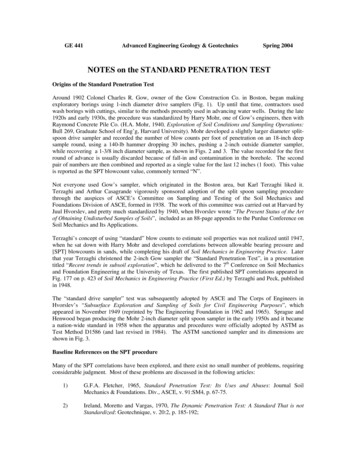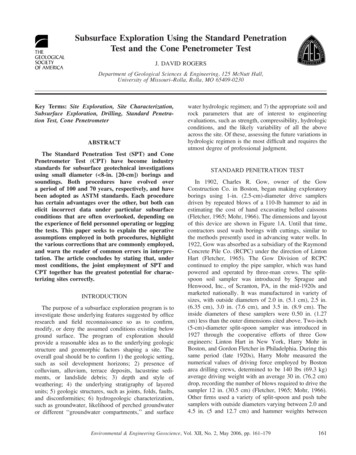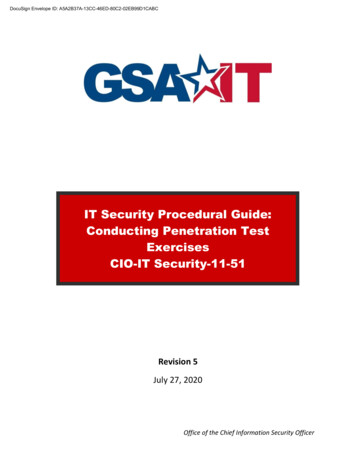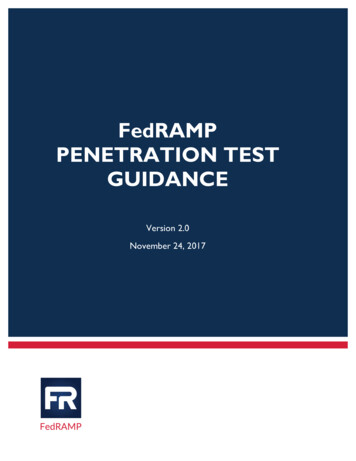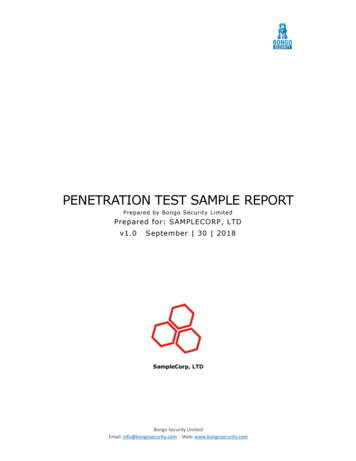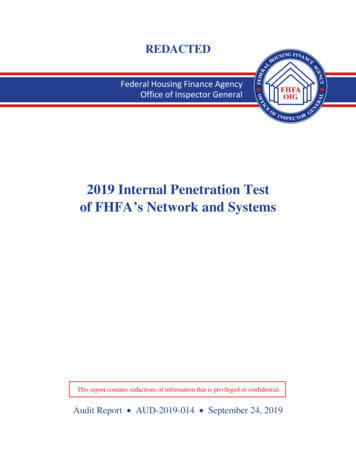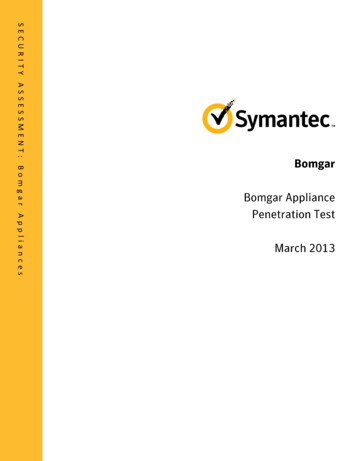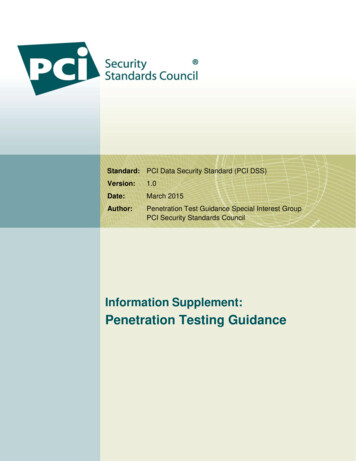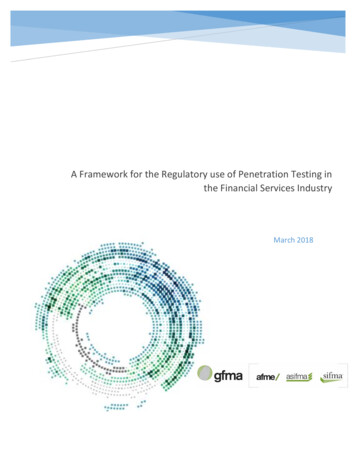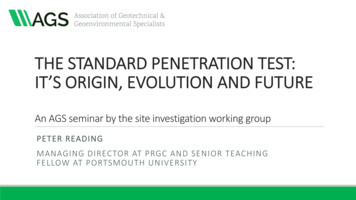
Transcription
THE STANDARD PENETRATION TEST:IT’S ORIGIN, EVOLUTION AND FUTUREAn AGS seminar by the site investigation working groupPETER READINGMANAGING DIRECTOR AT PRGC AND SENIOR TEACHINGFELLOW AT PORTSMOUTH UNIVERSITY
The SPT as we know the test todayTHE STANDARD PENETRATION TESTUsed to obtain penetration resistance NThe number of blows required to drive a 60 degree cone or split spoon 300mm using a 63.5kghammer falling 760mm
Timeline of the SPT developmento 1902: Colonel Charles Gow introduced a 1in. (25mm) tube sampler to provide samples from washboreboreholes, using a 100lb hammer winched by hand.o 1927: The Raymond Piling group incorporating the Gow Company reported to be using 2in (50mm) samplerwith spit spoon. A similar system in use around the same time by Sprague and Henwood. At this time thedrop weight was not standardised and ranged from 110lbs to 140lbs.The drop height was about 30inso 1947: Terzaghi and Peck describe the test and suggest that by counting the blows “useful information mightbe obtained”. At the 1947 conference on Soil Mechanics in Texas, Terzaghi coined the phrase standardpenetration testo 1957: Palmer and Stuart introduce the 60 degree solid cone.o 1963: Pilcon developed the Trip Monkey release mechanismo 1975: Following decimalisation in the UK the drop weight was standardise as 65kg and the drop height760mm (although this was not adopted at the time)o 2008: Measurement of Er was possible for the first time commercially in the UK.
Standardisation of the test procedureo 1957: BS CP2001 includes penetration tests in Appendix J201 and notes that “All test are empirical andtheir value lies in the amount experience behind them.”o 1967 BS 1377. Included as a sampling method where blows are recorded. Suggests results are modifiedwhen carried out in fine sand.o 1975: BS 1377 5.4 test 19 Specified a check valve and venting ports; test configuration of 65kg hammerfalling 760mmo 1990: BS1377 Part 9 A standardised test procedure is described. Several caveats are given to ensure astandard test procedure. Recommend a solid cone when carried out in granular soils and the notationSPT(C)o 1999: BS 5930. commentary suggest test results are only indicative with empirically derived relationshipso 2005: BS EN ISO 22476 Part 3 Further standardisation with the introduction of Energy Ratiodetermination a prerequisite. Requires rod stiffness to be considered (AW to 20m then BW below)o 2015: BS 5930 “gives an indication of RD and other parameters these are at best approximate,”
The SPT testBS EN ISO 22476 Part 3 (2005)Drive Weight AssemblyOverall mass 115 kgHammer mass63.5 0.5 kgDrop height760 10 mmDrive head (anvil) massunspecifiedo Rod straightness to be assessed and 1in 200o The energy ratio should be assessed.photograph courtesy of Equipe Group
Calculation of Energy Ratio (Er) as given in BS ENThe force transmitted to the rod is calculated as:-
Results of Energy Ratio testsEnergy Ratio (Er)(%)Energy Ratio for SPT Hammers and DynamicSampling Rigs1009080706050403020100050100150200250Maximum Force (Fmax)Dynamic Sampling WeightsMaximum value Er 89%SPT HammersAutomatic HammerMinimum value Er 43%Data provided by Equipe Group
Energy Ratio measurementThe range in energy ratio’s will have a significant effect on the resulting corrected N value whencorrection factors are applied. The Standard indicates that for general design and comparisonpurposes in sands, the N value should be adjusted to a reference energy ratio of 60%, by thefollowing equation:N60 Er N60where N is the blow count and Er is the energy ratio of the specific test equipmentUsing the data in the previous graphIf the energy ratio of two SPT hammers used on the same project in a uniform strata were 43%and 89% then the uncorrected values of N if 25 blows were recorded in the field would becorrected to 17 and 35, respectively
Results from SPT hammersEnergy Ratio (%)Energy Ratio per 0055.00050.00045.000115135155175195Maximum Force (Fmax)215Blow 1Blow 2Blow 3Blow 4Blow 5Blow 6Blow 7Blow 8Blow 9Blow 10Blow 11Blow 12Blow 13Blow 14Blow 15Blow 16Results from a poorly maintained hammerData provided by Equipe Group
Energy decay and other effectso Depth of test may contribute to a decline in energy ratio of up to 28% Lukiantchki (2015). Skempton(1986) suggested a correction for rod lengths of less than 10m, below this depth the effect is less clear.o There is a potential difference between using the open spoon and the solid cone. Thorburn (1986)suggested this may be as much as 100% in granular soils and chalk although, in the latter, the effect wasnot seen on all sites. Montague, 1990o The intervals are marked on the rods generally using chalk the penetration is measured judging by eyeagainst a datum usually the top or the casing.o Blows are counted manually for most tests
Some thoughts “There can be little doubt that the SPT N value is a very poor basis upon which to calculatefoundation settlement.” Clayton, 1995“The soil strength parameters which can be inferred are approximate” . “The test result isdependant on the diameter of the borehole and should not be regarded as standardpenetration tests.” BS 5930, 1999Many of our relationship curves have been developed over the years and have been used toconvert N values to a geotechnical parameter, most of these were based on SPT tests where theenergy ratio was not measured.
The future o Should we abandon the SPT for better and more expensive tests a few high quality tests areworth more than numerous bad tests?o Should we try to bring the SPT into the 21st Century with energy measurements for each blowand automatic penetration measurement and blow counts?o Further research to confirm design data for previous work and relationship formula and graphsusing SPT where the energy ratio is taken into account.
Acknowledgementso Equipe Group for much of the SPT test data and photographso Seminar Sponsors SOCOTEC
The number of blows required to drive a 60 degree cone or split spoon 300mm using a 63.5kg hammer falling 760mm. o1902: Colonel Charles Gowintroduced a 1in. (25mm) tube sampler to provide samples from washbore boreholes, using a 100lb hammer winched by hand. o1927: The Raymond Piling group incorporating the GowCompany reported to be using 2in (50mm) sampler with spit spoon. A
